Here are the most common certifications for assessing a product’s effect on indoor air quality and what these labels really tell us about the offgassing and toxicity of the products.
GreenGuard and GreenGuard Gold Certifications
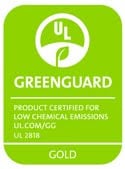
GreenGuard has two levels of certification that measure VOC levels in products.
GreenGuard allows – 500 μg/m3 total VOCs.
GreenGuard Gold allows – 220 μg/m3 total VOCs.
(GreenGuard Children and Schools which also measured for phthalates as well as VOCs, no longer exists).
For reference, the average house has a total VOC level of about 200 μg/m3, and the outdoor or “background rate” is about 1/10th of that (20 μg/m3).
GreenGuard Gold certification is the most useful of all the healthy product certifications out there for VOCs.
What Does GreenGuard Gold Certified Indicate for Formaldehyde Levels?
If you look through the individual levels of VOCs and their limits you can dig in even deeper.
The formaldehyde level allowed in GreenGuard Gold certified products is extremely low – just 9 μg/m3 or 7.3 ppb (parts per billion).
I have a post that contains a reference level table for formaldehyde. Outdoor urban air contains 1.5- 47 ppb. GreenGuard Gold formaldehyde levels are lower than the outdoor air in many places.
If you are looking at something like laminate or engineered flooring or cabinets and they meet Gold levels, that is a great indicator for low formaldehyde.
Formaldehyde levels allowed with standard GreenGuard are significantly higher at 50 ppb (parts per billion) or 61.3 μg/m3 (Compared to GreenGuard Gold 0.0073 ppm).
What Does GreenGuard Mean for Assessing Safety?
GreenGuard levels keep overall VOCs below limits that would adversely affect the health (of non-compromised individuals) based on the current state of knowledge.
However, for extremely sensitive people who are already compromised by toxin exposure, the level of VOCs in an average house may not be unacceptable, so even GreenGuard Gold levels may not be tolerable, especially when at the upper limits. Laminate flooring for example is not suitable for many people with chemical sensitivities, but engineered wood is.
My posts provide guides on the most important areas to focus on in a healthy house: Flooring, Cabinets, Insulation, Glues & Caulks, Paint, and Sealers.
Products, of course, are cumulative in a space. So it is important, especially when building new, to keep each material as low in offgassing as possible.
The GreenGuard tests attempt to show “real life” levels of VOCs, that might be expected in a regular-sized room after 7 days. (Source)
Downsides of GreenGuard Certification for Products
One tricky aspect of GreenGuard is that because it states that the levels are below the given threshold, you don’t know if the product is 220 or 0 μg/m3.
You still have to contact the companies to find out what the VOC level is – the problem is once they have this certification they don’t disclose the exact levels.
Many products like quartz countertops which claimed zero VOC before they were certified (and are probably very close to zero), now have GreenGuard Gold certification, and therefore we can’t know their exact offgassing levels.
Although this is the best certification right now for VOCs, it’s made things a little more difficult for very sensitive folks. We need to advocate for companies to release the actual results of the testing.
The certification does not limit sem-VOCs, like phthalates, biocides, and flame retardants. Nor heavy metals.
Note: GreenGuard measures the emissions and not the content in the material so these numbers cannot be converted to g/l (grams per liter).
Floorscore Certification
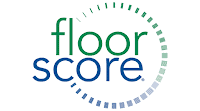
Floorscore – Floorscore has three tiers that you will see on the certificates: 0.5 mg/m3 or less, between 0.5 and 5 mg/m3, or 5 mg/m3 or more. (I’ve never actually seen the 5 mg or more category).
Floorscore certificates will indicate which range the product falls under.
There is no upper limit for total VOCs, they go by upper limits on each of the 35 Volatile Organic Compounds specified by the California Standard Method for VOC Emissions Testing and Evaluation (Standard Method V1.2), otherwise known as CA Section 01350.
The allowable limits of each VOC can be seen in the table on page 37 here.
What Floorscore Doesn’t Include
Chemical substances (on the CREL or other lists) that are not VOCs (e.g., metals, acids, semi-VOC plasticizers (eg phthalates), semi-VOC pesticides/biocides) are not required to be analyzed under this Standard Method.
Only 35 VOCs are tested for.
In other words, Floorscore only complies with the legally allowable VOC limits in California.
How Does Floorscore Compare to GreenGuard
When a Floorscore certificate indicates total VOCs (TVOC) of 0.5 mg/m3, this is the same level as standard GreenGuard (not Gold).
Therefore, if a product has GreenGuard Gold instead of Floorscore 0.5 mg/m3, the certification could indicate it offgasses a significantly lower level of VOCs.
If a company uses Floorscore they will use this across the board. It doesn’t help to differentiate which products are lower in offgassing.
You can see this dilemma in action when Mohawk bought Pergo floors and the laminates went from GreenGuard Gold to Floorscore certified (when I very much doubt the product itself changed).
Mohawk makes many other flooring lines that I doubt would meet GreenGuard Gold; I suspect that’s why they use Floorscore across the board.
All major flooring brands sold in the US and Canada likely meet the legal VOC limits in California and therefore meet Floorscore.
A flooring should certainly be able to achieve the lowest tier of less than 0.5 mg/m3, in my opinion. And most floors do.
Green Label Plus
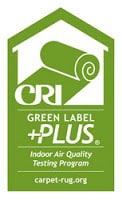
Green Label Plus – Certifies “very low” emissions on carpets, according to what they think is very low.
They test for 35 compounds listed under the California Department of Public Health’s Section 1350.
Each product category also includes additional compounds for certification, six for carpet, two for carpet pads, and seven for adhesives.
They meet or exceed California’s indoor quality standards for low-emitting products used in commercial settings such as schools and office buildings.
Is Green Label Plus a Useful Certification?
Here is the list of their levels of VOCs. I would find these upper limit levels to be too high for people with chemical sensitivities.
And, you would be hard-pressed to find a carpet in North America that can’t meet these limits.
This certification is made by the industry and is not helpful to me personally.
Here is my list of carpets that can do better than this.
Green Seal

Green Seal – Follows CARB (legal limits in California) levels of VOCs. More on CARB below.
For example, on paint, this is between 100-300 g/l (grams per liter) depending on the type of paint.
This is not a low enough level for most people with chemical sensitivities.
OSHA

OSHA is a Government Guideline – CA OSHA has the strictest government guidelines for VOCs in buildings. Here are their limits on VOCs.
While CARB and OSHA are definitely steps in the right direction, they promote levels of VOCs that will not cause adverse effects in healthy people.
These levels may not be acceptable for the extremely sensitive.
CARB
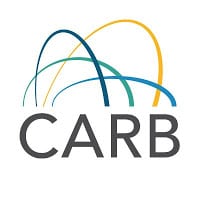
CARB – The California Air Resource Board establishes legally allowable levels of VOCs for California (which usually get adopted in any nationally distributed product).
They establish a maximum VOC content for consumer products sold in California. These are not necessarily “low VOC” in my definition.
For example, low-VOC paint means less than 50 g/l, while CARB legal allowable levels for paint are 100-300 g/l. (Note: zero-VOC means less than 5g/l).
CARB II formaldehyde levels are as follows:
Products measured include those containing hardwood plywood, medium-density fiberboard (MDF), and particleboard (like furniture and cabinets) – these are pressed wood products sold for indoor use. It does not include exterior sheathing products like exterior plywood and OSB.
CARB II Formaldehyde Limits are:
- Hardwood Plywood – 0.05 ppm (parts per million)
- Medium-Density Fiberboard (MDF) 0.11 ppm
- Thin MDF 0.13 ppm
- Particleboard 0.09 ppm
My post on pressed wood goes more into levels of formaldehyde and has a table that provides reference levels.
When a product says they meet CARB II all they are saying is they are complying with the law in California.
CARB limits have been extremely useful in mostly eliminating the use of the more toxic urea-formaldehyde in household wood products. A major shift to phenol-formaldehyde which offgasses faster and at lower levels was a huge accomplishment.
TSCA Title IV formaldehyde levels are the same as CARB levels.
CertiPUR
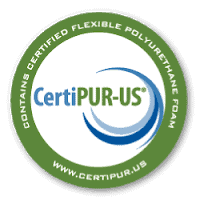
CertiPUR – This certification was created by the polyurethane industry to certify polyurethane foam.
All polyurethane foam should be able to meet this level of 0.5 ppm (or 500 μg/m3 total VOCs).
This level may be too high for most chemically sensitive people.
They would not give out info on how long polyurethane foam takes to completely offgas. Though I have to say, I don’t find basic polyurethanes to offgas very much, or for very long.
Most people are OK with a regular foam camping mat (my top picks reviewed here), mattress, or couch after some offgassing time.
Memory foam is higher in VOCs than basic polyurethane foam. My post on Mattresses goes into more detail.
While this certification provides a maximum level of VOCs (500 μg/m3), some polyurethane foam products can be as low as 72 μg/m3, which would be an acceptable level for many people.
I actually prefer polyurethane over natural latex which I explain in my posts on beds.
What Else is Regulated by CertiPUR?
Flame Retardants
This originally certified that foam is made without PBDE flame retardants (even when those were already banned).
Later they added that they are also made without TDCPP or TCEP (Tris) when those started being removed from most foam.
They really should lead the way to eliminate all toxic flame retardants, (which I discuss in my post on Flame Retardants).
Formaldehyde
They say they are “made without formaldehyde” but the allowable limit for formaldehyde in the final foam product is actually 100 μg/m3 (compared to the GreenGaurd Gold limit of 9 μg/m3).
Yet polyurethane is not made with formaldehyde. It’s possible they are allowing for formaldehyde donors, and that in some cases, such as when biocides are added, the final product could still contain formaldehyde up to 100 μg/m3!
Other VOCs
Other VOCs that are measured in the testing (and therefore are likely to be in at least some foam used in mattresses and furniture) include benzene, toluene, styrene, and aromatic hydrocarbons.
Phthalates
They say made without prohibited phthalates (not free of all phthalates).
Mercury, Lead, and Other Heavy Metals
While lead is not commonly found in polyurethane foam, it can be. At the time of updating this article in 2022, Certipur states that the foam is “made without lead”. The executive director actually clarified and said that they allow up to 90 ppm lead, which is below the level allowed in children’s toys.
Unfortunately, Certipur-certified foam did recently test higher than that for lead (source), so it’s not clear how diligently they are testing the foam.
GOTS Certified
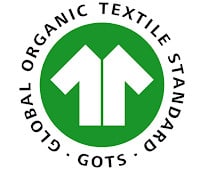
GOTS Certified Organic is a great certification to identify fabrics that are not only organic but safe from chemical processing.
Whenever possible I go for GOTS Certified products. This certification was definitely a step in the right direction.
GOTS Certified means (quoted from their website):
“A textile product carrying the GOTS label grade ‘organic’ must contain a minimum of 95% certified organic fibers whereas a product with the label grade ‘made with organic’ must contain a minimum of 70% certified organic fibers.
At all processing stages, organic fiber products must be separated from conventional fiber products and must be clearly identified.
All chemical inputs (e.g. dyes, auxiliaries, and process chemicals) must be evaluated and meet basic requirements on toxicity and biodegradability.
Ban on toxic heavy metals, formaldehyde, aromatic solvents, functional nano particles, genetically modified organisms (GMO), and their enzymes.
The use of synthetic sizing agents is restricted; knitting and weaving oils must not contain heavy metals.
Bleaches must be based on oxygen (no chlorine bleaching).
Azo dyes that release carcinogenic amine compounds are prohibited.
Discharge printing methods using aromatic solvents and plastisol printing methods using phthalates and PVC are prohibited.
Restrictions for accessories (e.g. no PVC, nickel, or chrome permitted, all polyester must be post-consumer recycled from 2014 onwards).
Packaging material must not contain PVC. From 1 January 2014 onwards, any paper or cardboard used in packaging material, hang tags, swing tags, etc. must be post-consumer recycled or certified in accordance with FSC or PEFC.”
All PFCs are prohibited.
OEKO-TEX Standard 100 Certified
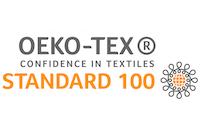
Oeko-Tex is the next best certification for textiles after GOTS.
The levels of chemicals allowed in Oeko-Tex certified products depends on what type of product it is.
There are different limits for household products versus clothes. The strictest standard is for baby clothes.
- Formaldehyde must be undetectable in clothes made for babies (but is allowed to some level in other textiles).
- Heavy metals, pesticide residue, chlorinated phenols, phthalates, organic tin, other harmful chemical residues, harmful dyes, PAHs, solvent residues, are all limited.
- PFAS are not allowed in baby clothes, and by January 1, 2024 will essentially be banned in all product categories including sofas.
- Certain flame retardant chemicals are not allowed – from Tris to Boric Acid (Annex 5, page 32).
GOLS Certified
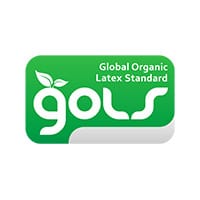
GOLS certification means a product must contain more than 95% certified organic raw natural latex.
The GOLS standard features permissible limits for harmful substances, emission test requirements, and polymer and filler percentages.
It prohibits polyurethane foam and some flame retardants, colorants, and allergenic dyes. It requires low emission of VOCs including formaldehyde.
I’m not a big fan of natural latex in general, which I explain in this post.
Why No Certification is Useful for Vinyl Flooring
Vinyl plank flooring offgases some aldehydes and a few other VOCs, all in extremely low amounts.
However, the main concern in vinyl flooring is the plasticizers. None of the above certifications are measuring or limiting plasticizers by volume, by type/toxicity, or by how stable they are in their chemical bond in the material.
Recycled vinyl can also contain toxic metals and toxic flame retardants – also not accounted for in any flooring certification. Virgin vinyl limits this problem. My post on vinyl flooring goes into more detail.
What Should the Chemically Sensitive Look For?
Zero-VOC
I like to see products close to 0-VOC for most applications – there are exceptions because there are exempt VOCs (though not that many), and some VOCs flash off so fast that we don’t need to worry about them.
No Flame Retardants
I would like to see a ban on ALL toxic flame retardants – I discuss flame retardants and which products you still find them in in this post. Flame retardants are not classified as VOCs.
No Toxic Metals
I would like to see toxic metals declared and reduced to the most minimal trace level (that is inevitable in natural products and minerals). Many products are actually moving towards toxic metals used as “safer” flame retardants like aluminum-based chemicals or antimicrobials (silver or copper), which is a problem in my opinion.
Regulations on Chemicals That Are Semi-VOCs
Phthalates should be eliminated from household products. Replacement plasticizers need to be disclosed, and we need to know more about their toxicity and leaching from the products.
Most biocides should be disclosed and avoided.
PFAS/PFCs should be avoided, in my opinion.
Products I Recommend
I always choose zero-VOC materials when available. You can find zero-VOC options for wallboards, insulation, siding, sheathing, flooring, paints, caulking, grout, thin set, tiles, beds, furniture, and windows.

Corinne Segura holds certificates in Building Biology, Healthier Materials and Sustainable Buildings, and more. She has 10 years of experience helping others create healthy homes.
Did you find this post helpful? If so you can buy me a coffee to support the research behind this blog. Thank you!

kcaz
So, given the limitations of GreenGuard Gold and other certifications, what material for shower walls and vanities and faucets/ shower systems (the hardest to track 100% lead free due to legally being able to have some lead) is the best? Is porcelain the lowest VOC or is sintered stone better? I see even Quartzite and some Granites have certifications which just makes things so much more complicated. I need the closest to zero for a bathroom remodel for shower walls, vanities and 100% lead free fixtures. Are there any designers that specialize in this type of remodel? It really is so confusing and hard to know where on the continuum of good to bad each certified (or uncertified) material / fixture falls. Thank you for your valuable posts.
Corinne Segura, Building Biologist
there’s an article on bathrooms that looks at shower materials, there is one on lead free faucets, one on formaldehyde free vanities, one on better tile brands, one on bathroom floors,
Rach
I’m looking at LVP floor for my basement rec room. We have had issues with water so it seems like it’s the best option. I care about our health and exposure to chemicals. Can someone tell me if it’s better to get proximity mills line that is zero voc but not listed as green guard certified or the Doma line that is green guard certified but low voc. Thx
Corinne
https://www.youtube.com/watch?v=bcE01_wqdGM
Corinne
watch this video, but green guard gold is totally useless for LVP
Jackie
Hi Corinne,
Thanks for the info! We recently bought a kitchen learning tower by Little Partners that claims to be GreenGuard Gold certified. It has a very strong MDF smell that doesn’t go away. So I tested it with our Temtop M10 home air quality monitor by placing the monitor inside of the enclosed space for standing. The TVOC reading is shocking at 690 μg/m3. I reached out to the company, and they said that home monitors are inaccurate, that their product is GreenGuard Gold certified, and that I need not to worry. But I do! We own various other furniture of the same standard and none of them smells. I wonder if I can ask the company to provide further testing record or have a professional come over to do testing so that the company will treat it seriously. Can companies make subpar product once they obtain the certification? I looked up their certification on the UL website and it expires in August. I just don’t feel safe having my kid spending a lot of time in it when I know there is something off with it, while the company is not doing anything about it. I appreciate your help.
Corinne
The GGG testing results are for the VOC level in the room that the object is in, assuming no other offgassing objects in the room. A product with MDF can qualify. If you don’t want that level of offgassing from MDF look for products without MDF, HDF or particleboard.
Allart
Forgot another question. Some foam shops make Sunbrella water resistant outdoor fabric encasements for their foam furniture. It is acrylic and though acrylic is bad, I read that Sunbrella fabrics have been certified by GreenGuard Children and Schools because the chemicals used in acrylic production are bound in the polymer, so don’t evaporate. Is this accurate? And what about skin contact with it?. I understand there are different grades of Sunbrella, don’t know if this makes a difference. Thanks again.
Allart
Great info, thanks. Have you done an article about the safest mattress and pillow protectors and encasements? I have allergies and need a new mattress and pillows for my RV, which became mold infected due to winter dampness.. So I will want to protect the new foam mattress and pillows with waterproof encasements that are hypoallergenic. Most I’ve found have a polyurethane membrane and the top is usually polyester. Don’t want polyester as it outgasses. Hard to find cotton or other natural fabrics on top. Some say antibacterial on the label, but is that because of the polyurethane or because of some kind of biocide, and if the latter, do any have natural biocides or are they all toxic?. The encasements I’ve seen are very thin and I wonder how long they’ll last, how many washings they can survive. And would these waterproof encasements keep any possible new mattress outgassing contained? Thanks for any help with this. Be well.
Lucy DeWolf
Dear Corinne,
I have a 2 year old granddaughter.
My daughter-in-law has been very careful to make healthy choices for her crib, and other things.
She got a Lotus Guava Travel Crib to leave at our house. it’s been in an upstairs airy bedroom.
We folded up the crib tonight as she asked us to bring it back on our visit. it is a very humid night. As my husband started to manipulate it to fold it up, I began to smell the chemical smell from this GreenGuard Gold certified product.. My throat began to burn and I had to leave and let him finish the job.
How can this crib be GreenGuard Gold and off gas so noticeably.? How protective is the specified VOC threshold, if the off gas is so evident?
Corinne
Hi Lucy, I don’t think any arbitrary certification will work for everyone (unless it certified 0 VOCs or other non-volitle toxins). So it’s all about the threshold that you are comfortable with both theoretically and personally in your body. If you notice that smell and have the throat burning that is a bad sign for sure.
Shirley J
What about natural organic latex mattress?
Corinne
That should be certified by GOLS.
Nichole
I just bought a crib that is greenguard gold certified but it still emitting a smell. Should I be worried?
Corinne
There is certainly offgassing from most products that have green guard. It just depends on your level of toxind avoidance. For people that are chemically sensitive this often isn’t good enough however the products that are labelled green guarse could be anywhere from zero VOCs to the top threshold. And in terms of deciding for a baby or young child you will have to decide on what is best based on what you think and possibly on if other people in the family have chemical sensitivities or impaired detox.
Ben Chilcote
Hi! We have been researching vinyl to replace old carpet in a new house we are moving into soon. Your website information has been very helpful and we have been leaning on it a lot, but I’m running into a confusing FloorScore certificate. It is for CoreLuxe from Lumber Liquidator. Here is a link to the certificate:
https://www.scscertified.com/products/cert_pdfs/LumberLiquidators_2020_SCS-FS-06137_s.pdf
In the certificate, it states:
Measured Concentration of Total Volatile Organic Compounds (TVOC): Less than/equal to 0.5 mg/m3 ; Between 0.5 – 5.0 mg/m3 ;Greater than/equal to 5.0 mg/m3 (in compliance with CDPH/EHLB Standard Method v1.2-2017)
I am waiting to hear back both from Lumber Liquidators and SCS on this but was curious how you would read this. Does this mean that their flooring tested positive in each of these tiers? Or does this seem like a clerical error? I wondered if this is related to the fact that the certificate lists multiple products for one certificate and therefore, among all products, measurements in all tiers were present. If that’s the case, it’s not at all helpful as it seems to completely negate the certificate.
Corinne
CoreLux is also Greenguard. All LVP will be in that lower tier. They are either not declaring or have multiple products under that certificate.
Jennifer
Hi! We’re planning to use Corelux Ultra, is this a safe product?
Corinne
Check out the flooring post for LVP https://www.mychemicalfreehouse.net/2019/09/zero-voc-flooring.html
Elizabeth
There is such a wide range of Pergo floors, several of which are waterproof and would be nice to use in a basement play space for small children. Is it possible somehow to figure out if they still meet Greenguard Gold standards? Are MSDS sheets usually available from retailers like Lowes or Home Depot if requested?
Corinne
All LVP would meet greenguard gold easily, mostly because the certification doesn’t test for plasticisers which appear to be the main problem with viny.
JeCsOn
hmmmm
Emmanuelle Sam
Its about time that we begin to use product that helps protect our environment. With all the climate change happening around the world it is but proper that we conserve paper help to lessen tree cutting.
Owen Scala
have you seen cowspiracy?
Saumya Thakur
I have seen cowspiracy, and adopted a plant based lifestyle!